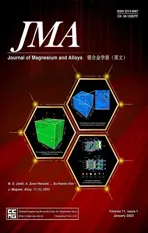Recent developments in high-pressure die-cast magnesium alloys for automotive and future applications
2023-03-24GerryGangWangWeiler
Gerry Gang Wang,J.P.Weiler
Meridian Lightweight Technologies,Strathroy,Ontario N7G 4H6,Canada
Abstract The use of magnesium alloy high pressure die cast (HPDC) components for structural applications,especially in the automotive and transportation industries,where weight reduction is of a great concern,is increasing.As new applications are developing and existing applications are becoming more complex,there is a need for improved properties from magnesium HPDC alloys.This paper reviews the recent developments in HPDC magnesium alloys for transportation applications.Compared to the conventional HPDC magnesium alloys,i.e.AZ91D,AM50A/AM60B and AE44,these new alloys have one or more of the following properties: higher strength,higher ductility,superior high-temperature properties or higher thermal conductivities.In this work,characteristics which are important in product manufacturing or product performance will be evaluated and discussed,including die castability of powertrain component or thin-walled structural component,mechanical properties at elevated temperatures and ductility.Results indicate that these alloys have great potentials to be added to the current magnesium HPDC alloy family and being used in actual automotive and other transport applications.
1.Introduction
High-pressure die-castings produced using magnesium alloys are one of the most used structural metals in the automotive industry for lightweighting objectives [1].The density of magnesium alloys is about 33% less than aluminum alloys and 75% less than steel,and its Young’s Modulus is about 20 times greater than polymer composites [2].Magnesium alloys have high fluidit [1] and minimal affinit for tool steel due to the fact that iron (Fe) has a low solubility in Mg[3].These properties combined with its low-density advantage make them very suitable for the high pressure die casting (HPDC) process [4].With modern HPDC technologies,magnesium alloys can be produced in near-net shape products with large,thin-walled and complex geometry,exhibiting outstanding structural and functional performance [4,5].Magnesium HPDC products can be joined in multi-material automotive applications with thread forming fasteners in ascast states which leads to eliminating drilling/tapping operations.This provides significan advantages for the assembly process,and overall cost benefi and joint integrity [6] as well as good potential for alternative industry applications.
Traditional industrial alloys used for high-pressure diecastings in the automotive industry are based on the Mg-Al system and the most recent improvement on these is the development of high-purity compositions nearly 40 years ago.AZ91D is used where a high strength at moderate temperature is desired;AM50A/AM60B are used where a high ductility is required,while AE44 is used for elevated temperature applications.Modern HPDC alloys are of high purity with impurities such as Fe,Cu and Ni strictly controlled.They therefore have excellent general corrosion resistance for automotive and other applications [7–9].
In the last 10 years,there has been some developments in high-pressure die-cast alloys for automotive applications,and this paper attempts to summarize these and provide po-tential applications for these alloys in the automotive industry,as well as for future transportation industry applications.These new alloys are classifie into magnesium alloy compositions with higher strength,higher ductility,superior hightemperature properties,high physical properties,or a combination of above properties using the traditional Mg-Al system,and newer compositions that are Al-free.HPDC die castability and performance properties of these alloys will be evaluated and discussed.
2.Mg-Al based alloy developments
2.1.Higher strength alloys using Sn additions
The addition of Sn in magnesium alloys had been reported to provide some strengthening at the expense of ductility[10,11].There are some controversial results on the effect of the addition of Sn on the fluidit and die castability.It has been reported that the addition of Sn at contents above 0.3%improves the castability and reduces die sticking of Mg-Zn-Al and Mg-Al-Mn magnesium alloys [12,13].Further,the addition of up to 0.5% Sn to AZ91D was found to improve the fluidit,but act to decrease the fluidit when tin is greater than 0.5% [14].The discrepancy in the effect of Sn on castability comes mainly from the differences in the amount of Sn added and the compositions of the base alloys.
Over the past 10 years,a new HPDC alloy family based on Mg-Al-Sn has been developed which offers a good combination of strength,ductility,castability and corrosion resistance[15–20].This alloy family can be further classifie into two groups,with or without Si addition.
Representatives of this Mg-Al-Sn (without Si) alloy family are AT72 (Mg-7Al-2Sn) and AT96 (Mg-9Al-6Sn),of which the compositions are shown in Table 1.With the increasing Al and Sn contents,the non-equilibrium (Scheil model) freezing range of Mg-Al-Sn alloys is similar to that of AZ91 alloy.Further,the Mg-Al-Sn alloys have similar eutectic fractions as that of AZ91D,indicating they have comparable castability to AZ91 [15].

Table 1 Chemistry of the Mg-Al-Sn alloys (mass fraction,%) [15].

Table 2 As-cast mechanical properties of HPDC alloys [15].
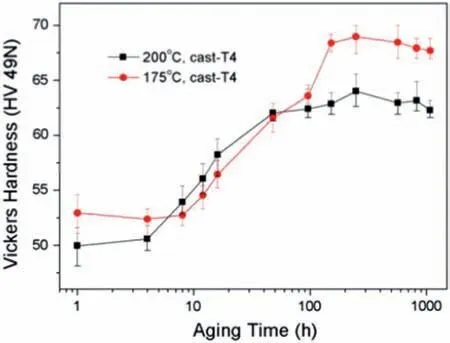
Fig.1.Aging curves of T4 heat treated AT72 HPDC specimens aged at 175 °C and 200 °C respectively [19] (Copyright 2013 by The Minerals,Metals &Materials Society.Used with permission).
Table 2 shows the as-cast mechanical properties of the Mg-Al-Sn alloys comparing to those of common HPDC Mg alloys,AZ91 and AM50.Due to the further strengthening effect of Mg2Sn phase,the Mg-Al-Sn alloys have significantl higher yield strength compared with those of conventional die cast magnesium alloys (AZ91 and AM50),at the expense of ductility.Again,the chemistry of the Mg-Al-Sn alloys can be tailored to provide different combination of properties.For example,the AT96 alloy has higher strength but lower ductility,while the AT72 alloy has a more balanced increase in both strength and ductility [15].Therefore,AT72 has received much attention for automotive applications.It is reported that,under the tested strain rate of up to 1000/s,the AT72 has a slightly positive strain rate effect with the increase of strain rates under both tension and compression loadings[16].These results are consistent with ordinary Mg-Al HPDC alloys such as AM50A,AM60B or AZ91D [21].
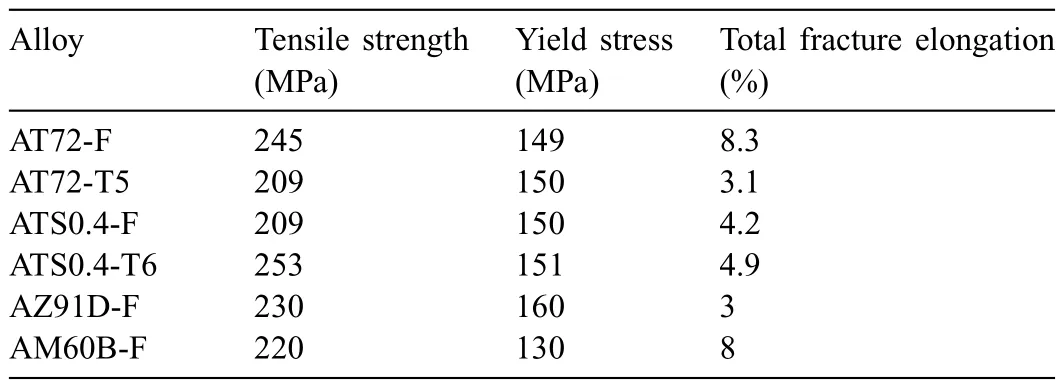
Table 3 Mechanical properties of HPDC AT72 and ATS alloys [8,22].
Unlike the common Mg-Al HPDC alloys such as AZ91D,AM50A or AM60B,the Mg-Al-Sn alloys can be strengthened through precipitation hardening from the Mg17Al12and Mg2Sn phases [17–19].Fig.1 shows the hardness changes of the AT72 HPDC specimens after solution treatment at 410°C/16 h then aged at 175°C and 200°C[19].AT72 alloy has a significan age-hardening response.Close examination of the results in Fig.1 indicates that the reaction kinetics of the precipitation hardening effect is slow.For example,it will take around 200 h at both 175 °C and 200 °C to reach peak hardness,which is a challenge for automotive manufacturing industry to incorporate into high-volume processes.
To improve the slow reaction dynamic of the aging response of AT alloys,the effect of the addition of Si was studied.The AT alloys containing Si are named as ATS alloys.Based on the CALPHAD (CALculation of Phase Diagrams)approach,AT72 alloys containing 0.25% Si (ATS0.25) and 1.5% Si (ATS1.5) were developed [20].As shown in Fig.2,the addition of 1.5% Si indeed shortened the peak aging time.In addition,adding 1.5%Si also resulted a significan increase in age hardening effect.
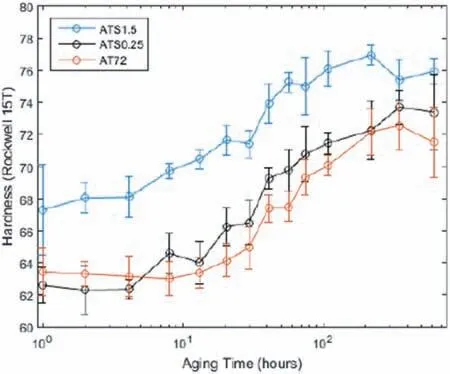
Fig.2.Aging curves of T4 heat treated (420 °C/10 h) ATS and AT72 HPDC specimens aged at 200 °C [20] (Copyright 2016 by The Minerals,Metals &Materials Society.Used with permission).
The Mg-Al-Sn alloy family has been further refine through composition optimization,casting process development and heat-treatment development.As shown in Table 3,the HPDC AT72 specimens have comparable strength to AZ91D and ductility to AM60B,which makes this alloy very attractive for automotive applications where energy management during crash is needed,such as side door applications[22].Further work is still needed to improve the precipitation hardening responses of both AT72 and ATS alloys,where potential applications include body structure castings,such as pillar structures,or strut tower mounts.
2.2.Higher elongation alloys using Zn additions
The Mg-Al-Zn HPDC alloy family has once been the primary research focus in the past[23,24].One of the advantages of this alloy family is that they have the lowest metal cost comparing to other Mg HPDC alloys since the main alloying elements are widely available.The primary composition of this alloy family is AZ91D HPDC alloy which has been and still is the main alloy for automotive applications such as powertrain components[3].There is some recent development in this alloy family which is mainly on wrought components[25–27].
A newly developed Mg-Al-Zn-Mn HPDC alloy system has been recently reported (Fig.3) [28].Five Mg-Al-Zn-Mn compositions were cast along with AM60B and AM50A as comparisons.The chemical compositions of the alloys are listed in Table 4.
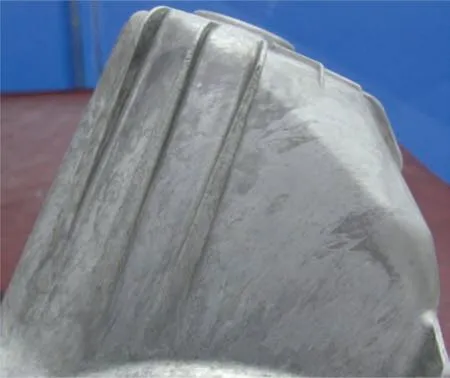
Fig.3.HPDC automotive component casting used in the Mg-Al-Zn-Mn alloy development.

Table 4 Chemistry of the Mg-Al-Zn-Mn alloys and AM50/60 alloys(mass fraction,%)[28].
The HPDC castability of the alloys was evaluated based on surface quality and soundness of 20–30 castings from selected alloy compositions [28].Table 5 lists the total surface anomaly occurrences of selected alloys,as well as the soundness of castings using density measurements.The Group 1 and Group 4 compositions of the Mg-Al-Zn-Mn alloy were found to have better surface qualities than the AM50A/AM60B baseline castings,while the Group 2 composition has a similar surface quality to the AM50A/AM60B baseline castings.As shown in Table 5,the castings made of the Mg-Al-Zn-Mn alloy family have improved soundness than the baseline castings made of AM50A/AM60B alloy.
The tensile mechanical properties of the Mg-Al-Zn-Mn alloy family castings are shown in Table 6.Table 6 shows that Group 1 alloy composition shows higher ductility than the baseline AM alloys,while Group 4 alloy shows higher yield strength than baseline AM alloys.Therefore,the mechanical properties of the Mg-Al-Zn-Mn alloy family can be tailored by varying Al and Zn contents.

Table 5 Average casting anomalies occurred on the as-cast surface and gross porosities of selected compositions [28].

Table 6 Average tensile properties of coupons cut from various locations of selected alloys [28].
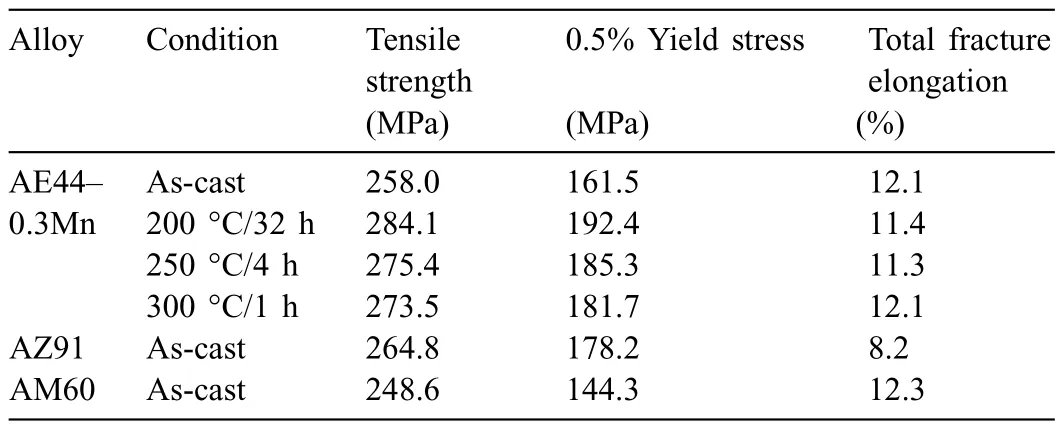
Table 7 Average ambient temperature tensile properties of the AE44–0.3Mn alloy in the as-cast and peak-aged conditions [35].
The ductility of the Mg-Al-Zn-Mn alloy family castings were also evaluated through bending tests on square coupons per VDA 238–100 standard.As shown in Fig.4(a),the bending ductility of Mg-Al-Zn-Mn alloy family is higher than AM60B alloy,and Groups 1 to 3 have ductility values higherthan or equal to the AM50A alloy.Fig.4(b) shows that ∼5 atom% total alloying element addition seems to a threshold to the ductility of the Mg-Al-Zn-Mn alloy family.With below 5 atom% total element addition,the bending ductility doesn’t change significantl,while with above 5 atom% total element addition,the bending ductility decreases significantl .For a combined ductility and strength,the combined Al and Zn addition should be around 4.5 atom%.

Fig.4.Average bending angles of the Mg-Al-Mn-Zn alloy family versus AM alloys [28].
Above results indicate that the Mg-Al-Zn-Mn alloy family,with 4–5% Al and 0.4–1.2% Zn,can be easily cast into very complicated thin-walled geometry through HPDC process.The surface and internal quality of the Mg-Al-Zn-Mn castings are superior or similar to the current ductile HPDC alloys (AM50A or AM60B).In the addition range of the present work,the addition of Al and Zn will increase the strength but decrease the ductility of the alloys.The Mg-Al-Zn-Mn alloy family also has higher ultimate tensile strength than the AM alloys.The ductility of the Mg-Al-Zn-Mn alloy family can be the same as or higher than the AM alloys by varying the Al and Zn concentration.The improved elongation of a HPDC magnesium alloy in automotive applications can be used in several existing applications to optimize weight re-duction as well as in body structure castings where additional ductility is needed.
2.3.Improved high-temperature properties with Re additions
Rare earth elements were firs investigated as alloying elements for magnesium alloys in the 1930′s [29].Later,AE42 was developed which has the best combination of properties at room temperatures and die castability similar to AZ91D for automotive powertrain applications [30,31].Comprehensive work was carried out by Hydro Magnesium which led to the commonly used AE44 HPDC alloy [32,33].This alloy was firs used on the 2006 Corvette Z06 structural cast magnesium crossmember [34] and is still the main magnesium HPDC alloy for high temperature automotive applications.
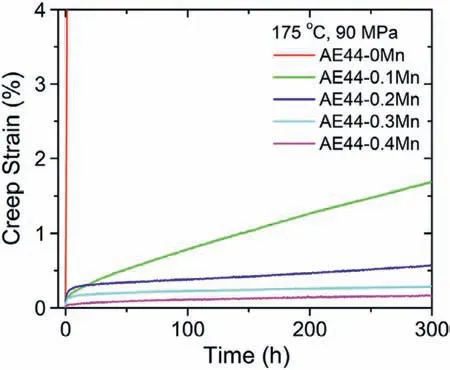
Fig.5.Creep properties at 175 °C and 90 MPa of the AE44 alloys with various Mn contents [35] (Copyright 2021 by Elsevier.Used with permission).
Recently the mechanical properties and creep properties of the AE44 HPDC alloy was re-evaluated [35–37].The alloy was found to have a remarkable age-hardening response,thanks to the precipitation of nanoscale Al-Mn particles [36].As shown in Table 7,the AE44 alloy containing 0.3%Mn has remarkable improvements in strength under various T5 conditions.The peak aging occurs at 200 °C.It is also important that this hardening effect is not accompanied by a significan loss in ductility due to the nano-scale nature of the precipitation particles.This type of age hardening effect was also found in Mg-4Al-3La-1Ca-0.3Mn alloy [38].In this new alloy,the aging hardening effect was even more significan due to the precipitation of nanoscale Al2Ca in grains,in addition to the Al6Mn nano-particles [38].Based on the overwhelming evidence of the age hardening effects by Mn addition to Mg-Al alloys,it is reasonable to assume that other Mg HPDC alloys containing Mn elements,such as AM50A and AM60B,might have similar characteristics.Therefore,these finding on age hardening effects by the minor Mn additions will provide Mg HPDC alloys more opportunities for automotive applications such as in electric vehicle (EV) and hybrid electric vehicle (HEV) applications (motor housings,battery trays,invertors,etc.) where the peak temperature required is reduced from Internal combustion engine (ICE) vehicle applications.
The role of Mn in AE44 on creep resistance was also studied.It was found that at 175 °C and under a stress of 90 MPa,the minor addition of Mn in AE44 have a remarkable influenc in improving creep resistance for AE44 as shown in Fig.5 [35].This is likely due to the precipitation hardening of nano-scale Al-Mn particles [35].This findin challenged the general consensus that the superior creep resistance of die case AE44 is due to the formation of the Al-RE intermetallic phases at the grain boundaries.
2.4.Improved high-temperature properties with Ca and Ba additions
In addition to rare earth elements,the addition of calcium(Ca) to the Mg-Al alloy systems can also improve high temperature properties of high-pressure die-cast magnesium alloys [39].One of the more commonly used Mg-Al-Ca alloys is MRI 230D which was introduced in the early 2000s[39,40].Recently,there has been a renewed interest in thisalloy system,such as the development of the DieMag alloy system [41–43].The DieMag alloy system is based on the Mg-Al-Ca system with barium (Ba) additions using a nominal Al:Ba:Ca ratio of 2:1:1 as shown in Table 8.This alloy system was firs introduced as a permanent mold alloy [41].But it can be die-cast using the HPDC method.The mechanical properties of this alloy system can be tailored by varying the amounts of Al,Ca and Ba.As shown in Table 9 [43],at room temperature,by varying the alloying elements,the Yield Strength of DieMag alloys can range from 140 MPa to over 200 MPa [43].However,this negatively affects the ductility.At elevated temperature (150 °C),the mechanical properties of DieMag422 are almost identical to those of MRI230D,while DieMag633 has higher UTS and yield strength than MRI230D (Table 9).The development of these alloys is relatively newer,and we have yet to see any applications in the automotive industry.

Table 8 Chemical compositions (wt.%) of die-cast DieMag alloys [42].
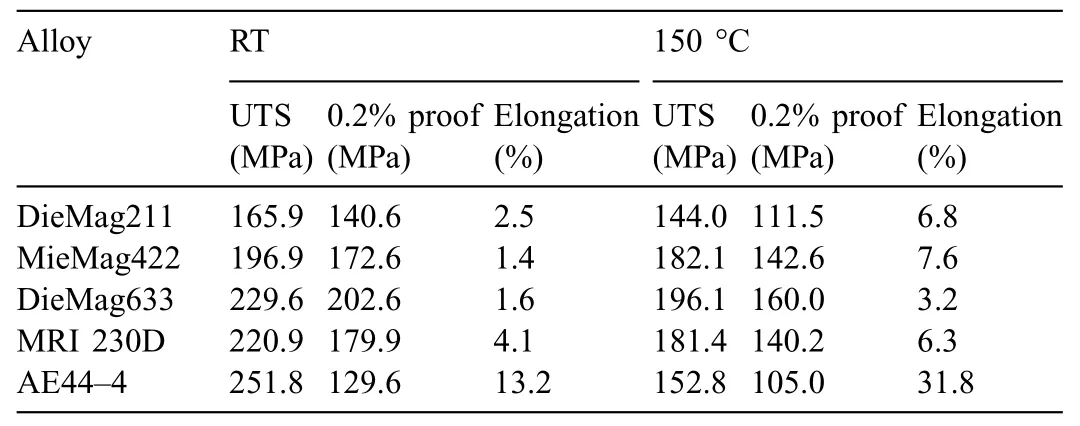
Table 9 Average tensile properties at ambient and elevated temperature [43].
2.5.Improved thermophysical properties with Ca and RE additions
Common Mg HPDC alloys,such as AZ91D and AM60B,have relatively low thermal conductivity which hinders their applications in the EVs,HEVs,and computer,communication and consumer product (3C) applications.To improve the thermal conductivity of the Mg HPDC alloys,the effects of the addition of Ca into Mg-Al-Zn-RE were explored which resulted in a new Mg-4Al-4Zn-4RE-1Ca (AZEX4441) HPDC alloy [44].This alloy has strength close to that of AZ91D but has much higher thermal conductivity (Table 10).In the AZEX4441 alloy,the Al and Zn were largely bounded by RE and Ca to form Al11RE3,Al2REZn2and Ca2Mg6Zn3phases.Therefore,the lattice distortion is much lower than that of the AZ91D alloy,resulting the high thermal conductivity.
Dead Sea Magnesium developed a new Mg-Al-RE alloy to target the EV and HEV applications.This new alloy,com-mercialized as DSM-1 alloy,is an advanced magnesium alloy for HPDC applications [45].As shown in Table 11,this new alloy has excellent strength and ductility at ambient and elevated temperatures.In addition,the mechanical properties can be strengthened via a T5 age hardening process.One superior property of this alloy is its high thermal conductivity,a favorable characteristic for EV and HEV applications.As shown in Table 12,DSM-1 alloy has higher thermal conductivity than most common Mg HPDC alloys.Its thermal conductivity is comparable to that of Al HPDC A380 alloy.These excellent physical and mechanical properties,combined with its good die castability,make the DSM-1 Mg HPDC alloy to be a good material choice for the emerging EV/HEV applications.

Table 10 Physical and mechanical properties of the AZEX4441 alloy HPDC [4444].

Table 11 Average tensile properties of the DSM-1 alloy in as-cast condition [45].

Table 12 Thermal conductivity of as-cast HPDC Mg-Al alloys (as a comparison to HPDC Al 380).
Further work has been conducted by adjusting the RE element type or amount in the HPDC Mg-Al-RE alloy family to improve some specifi properties,such as high temperature creep resistance,strength or ductility [48–54].It has been reported that the Mg-4Al-3La-2Sm-0.3Mn HPDC alloy can have ultimate tensile strength of 266 MPa,yield strength of 170 MPa and elongation of 11.2% [48].With 2% Ca addition,the AEX422 (Mg-4Al-2RE-2Ca-0.3Mn) HPDC has a yield strength of 204 MPa,at the expense of ductility [49].The effects of individual Rear Earth elements in Mg-Al based alloy family,including Ce[50],La[51],Nd[52],and Pr[53],were systematically studied.It was found that the balanced properties,including ambient strength and high temperature properties,can be obtained by adding 2% Gd into the Mg-4Al-3La-0.3Mn alloy thanks to the fine grains,and multiscale and multi-typed intermetallic phases [54].
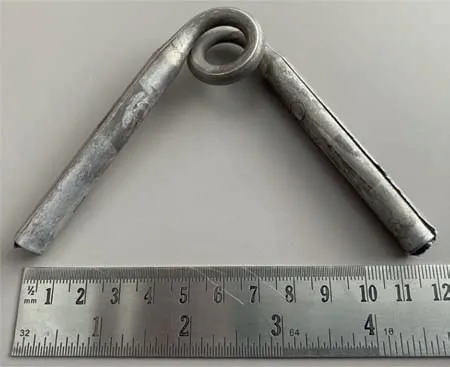
Fig.6.Pit-tail test result of HPDC MRI 260D tensile bar (as-cast).
3.Al-free Mg alloy developments
3.1.MRI 240D/250D/260D
This alloy family is Dead Sea Magnesium’s latest breakthrough in HPDC Mg alloy developments.They are based on the Mg-Zn-Zr-RE alloying system [55].The alloy MRI 250D contains the highest amount of alloying elements while the alloy MRI 260D has the least amount of alloying elements.As expected,MRI 250D is the strongest alloy and MRI 260D is the most ductile alloy (Table 13).It is worth noticing that the MRI 240D/250D/260D alloy family has very high ductility in general,as compared to the common ductile HPDC Mg alloys (AE44 or AM50/AM60).The elongation of the least ductile MRI 250D is still 60% higher than that of the most ductile common HPDC Mg alloy,AM50 (Table 13).Fig.6 demonstrates the high ductility of the MRI 260D alloy in as-cast state.Dead Sea reports that these alloys have very good fluidit and die castability.

Table 13 Average ambient temperature tensile properties of the MRI 240D/250D/260D alloy family in the as-cast condition as compared to those of AM50A/AM60B and AE44.

Table 14 Average ambient temperature tensile properties of the MRI 240D/250D/260D alloy family in T5 condition as compared to those of as-cast AM50A/AM60B and AE44.

Table 15 Measured chemical composition of the newly developed die-cast Mg-RE-Al alloy [58].
In addition to the superior mechanical properties in as-cast state,the MRI 240D/250D/260D alloy family has good age hardening response.As shown in Table 14,under T5 heat treatment condition,there is a significan increase in strength at the expense of ductility.Comparing to common ductile HPDC Mg alloys on the market today,the T5 treated new MRI alloys are much stronger and more ductile.With a potential for improved elongation and/or strength,these alloys have potential for body structure casting applications in the automotive industry.
3.2.Mg-RE based HPDC magnesium alloys
A new alloy based on the Mg-RE-Al HPDC alloy has been reported which is suitable for applications at temperatures up to 200–300 °C [58].As shown in Table 15,this alloy contains about 5% rare earth elements and about 0.5% of Al.The Mg-(La+Ce)-Al acts as the base of the alloy.The other RE elements Nd and Gd are strengthening elements for high temperature properties [58–60].Comparing to the commonly used high temperature HPDC Mg alloy AE44,this new alloy has higher yield stress but much lower ductility (Table 16).At high temperatures such as 250 °C,this alloy shows great strength and ductility over the AE44 alloy.
王沪宁代表党中央在中国工会第十七次全国代表大会上的致词中强调:各级工会要顺应职工群众对美好生活的向往……要健全工会服务职工体系,做实服务职工工作,把党和政府的关怀与工会的温暖送到广大职工心坎上,成为职工信得过、靠得住、离不开的知心人、贴心人、“娘家人”。
The rare earth element Gd has been added to form Mg-8Gd-1Dy-0.3 Zn (wt.%) and found to have high mechanical properties at temperatures up to 300°C[61].The HPDC alloy GW63K (Mg-6Gd-3Y-0.5Zr) was also developed [62].Even though this alloy has high strength and ductility at ambient temperature,its optimized condition is under T6 condition.Under the T6 condition,this alloy exhibits extremely high strength and maintains reasonable ductility as shown in Table 17.
A comprehensive study was carried to study the Mg-0.45La based HPDC alloys with various amounts of Nd,Y or Cd [63].They found that adding a small amount of soluble ternary rear earth elements,such as 0.2 at% Nd,Gd or Y,can significantl improve the high temperature creep resistance of the Mg-0.45La based HPDC alloy.Comparatively,elements Gd and Y are more efficien than the element Nd.One thing worth noticing is that Mg-La alloy family has been reported to have high thermal conductivity [64].As reported in [64],the Mg-La alloy family can have a thermal conductivity as high as 115 W/m-K,which is much higher than that of commonly used Al380 HPDC Al alloy (96 W/m-K [47]).Therefore,this alloy family has a potential for future EV/HEV applications.
The Mg-Nd-Zn-Zr alloy family was initially studied as an extrusion alloy or a gravity casting alloy [65–68],which showed high strength and good corrosion resistance.The microstructure and tensile properties of a Mg-3.0Nd-0.3Zn-0.6Zr were investigated in vacuum-assist HPDC condition [69].It was found that by properly design the runner the elongation of this HPDC alloy can approach 10% fracture elongation.
The Mg-Y alloy family has been thoroughly studied in the past,which resulted in the popular Mg alloy WE43 [70–72].The WE43 cast alloy has strength for use at temperatures up to 300 °C and satisfie flammabilit per FAA (Federal Aviation Administration) test procedure,thus has the potential foraircraft interior applications [73,74].Most work on this alloy family is for gravity casting or extrusion with various post heat-treatment process [75].Recently,a HPDC Mg-Y alloy,Mg-6Y-3Zn-1Al (WZA631) was reported [76].The composition of this alloy is shown in Table 18.Comparing to the popular WE43 gravity alloy in T6 heat treatment condition,this HPDC alloy has similar strength but much higher ductility in as-cast condition as shown in Table 19.According to[77],the addition of 5.8%Y into Mg can increase the ignition temperature by 50 °C (from 625 °C to 665 °C).Thus,this Mg-6Y-3Zn-1Al alloy is expected to have good flammabilit resistance.Therefore,it might be suitable for airplane seating applications where both high flammabilit resistance and high ductility are needed.

Table 16 Average tensile properties of the investigated die-cast Mg alloys at ambient and elevated temperatures [58].

Table 17 Average tensile properties of GW63K HPDC alloy under different die casting conditions and heat-treatments[62].

Table 18 Actual chemical composition of the newly developed WZA HPDC alloy [76].

Table 19 Mechanical property comparison of Mg-Y alloys.
4.Summary and outlook
The newly developed HPDC magnesium alloys are targeting higher strength,higher ductility,superior high-temperature properties,higher thermal conductivity or a combination of above.Only a few new alloys were evaluated with HPDC die castability,which is a very important industrial factor when evaluating new alloys for automotive or transportation applications.
The main research focus of the HPDC magnesium alloy is still on Mg-Al based alloys.Some new HPDC alloys are being developed based on the traditional Mg-Al-Zn-Mn system for balanced mechanical performance and alloy cost.Some are based on the traditional Mg-Al-RE system for improved ambient temperature properties and high temperature properties.The others are based on the addition of new alloying elements such as Sn to obtain optimized precipitation hardening response of the alloys.
Among the alloying elements used for HPDC magnesium alloys,the rare earth elements received most attention.Thus a few new HPDC alloys based on Mg-RE system were developed for the purpose of obtaining improved high temperature creep resistance.In addition to adding multiple RE elements such as AE44 alloy,some new development is based on using single rare earth element such as La,Nd et al.
A new trend of HPDC alloy development is to obtaining high thermal conductivity for 3C and EV/HEV applications.The thermal conductivities of some newly developed HPDC magnesium alloy are the same as or high than the common HPDC aluminum alloy A380.It is expected that in the near future,more work will be carried in this aspect.With some pioneer work on the Mg-Y alloy,it is possible that new HPDC magnesium alloys will be developed and utilized in commercial airplane applications.
Acknowledgements
The authors would like to thank Dr.Xu Wang and Dr.Yousef Tabatabaei for critical review of the manuscript.
猜你喜欢
杂志排行
Journal of Magnesium and Alloys的其它文章
- Formation of carbon and oxygen rich surface layer on high purity magnesium by atmospheric carbon dioxide plasma
- Local hardening and asymmetric twin growth by twin-twin interactions in a Mg alloy
- Brittle and ductile characteristics of intermetallic compounds in magnesium alloys: A large-scale screening guided by machine learning
- Experimental study on uniaxial ratchetting-fatigue interaction of extruded AZ31 magnesium alloy with different plastic deformation mechanisms
- Assessment of Mg(OH)2/TiO2 coating in the Mg-Ca-Zn alloy for improved corrosion resistance and antibacterial performance
- Simultaneous refinemen of α-Mg grains and β-Mg17Al12 in Mg-Al based alloys via heterogeneous nucleation on Al8Mn4Sm
